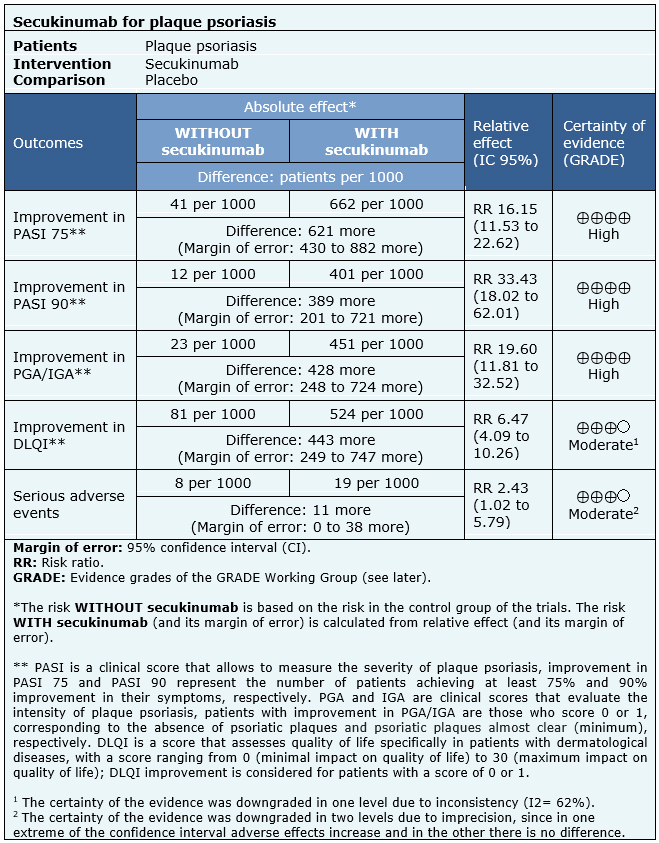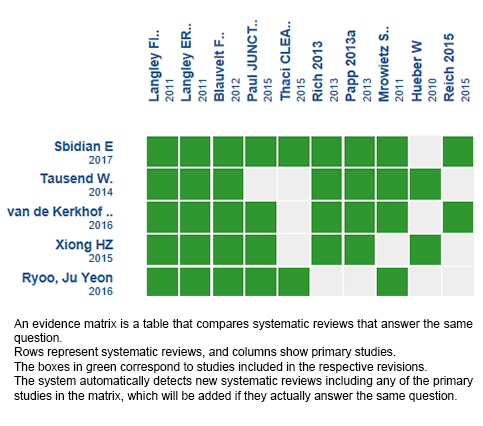Resúmenes Epistemonikos
← vista completaPublicado el 30 de noviembre de 2018 | http://doi.org/10.5867/medwave.2018.07.7363
Secukinumab para psoriasis en placa
Secukinumab for plaque psoriasis
Abstract
INTRODUCTION Biological treatments have appeared as the main alternative for the management of patients with plaque psoriasis that do not respond to conventional treatment. So, evaluating its actual efficacy and safety is needed.
METHODS We searched in Epistemonikos, the largest database of systematic reviews in health, which is maintained by screening multiple information sources, including MEDLINE, EMBASE, Cochrane, among others. We extracted data from the systematic reviews, reanalyzed data of primary studies, conducted a meta-analysis and generated a summary of findings table using the GRADE approach.
RESULTS AND CONCLUSIONS We identified 21 systematic reviews including ten studies overall, of which all were randomized trials. We concluded secukinumab achieves clinical improvement in patients with plaque psoriasis, although it is probably associated with serious adverse effects.
Problem
Approximately 20% of patients with plaque psoriasis have moderate to severe disease [1], requiring conventional systemic treatment, such as methotrexate, cyclosporine or acitretin, or phototherapy. However, for a large number of patients, these treatments are not sufficient, due to a limited therapeutic effect or to the presence of adverse effects.
In the search for more effective and safe treatments, biological therapies have emerged in the last years as an alternative. Secukinumab is a human monoclonal antibody that selectively neutralizes interleukin-17A, which has a major role in the pathogenesis of psoriasis. We aimed to evaluate the efficacy and safety of secukinumab in patients with plaque psoriasis.
Methods
We searched in Epistemonikos, the largest database of systematic reviews in health, which is maintained by screening multiple information sources, including MEDLINE, EMBASE, Cochrane, among others, to identify systematic reviews and their included primary studies. We extracted data from the identified reviews and reanalyzed data from primary studies included in those reviews. With this information, we generated a structured summary denominated FRISBEE (Friendly Summary of Body of Evidence using Epistemonikos) using a pre-established format, which includes key messages, a summary of the body of evidence (presented as an evidence matrix in Epistemonikos), meta-analysis of the total of studies when it is possible, a summary of findings table following the GRADE approach and a table of other considerations for decision-making.
|
Key messages
|
About the body of evidence for this question
|
What is the evidence. |
We found 21 systematic reviews [2], [3], [4], [5], [6], [7], [8], [9], [10], [11], [12], [13], [14], [15], [16], [17], [18], [19], [20], [21], [22] that included ten primary studies, reported in 23 references [23], [24], [25], [26], [27], [28], [29], [30], [31], [32], [33], [34], [35], [36], [37], [38], [39], [40], [41], [42], [43], [44], [45], all corresponding to randomized controlled trials. However, four of these trials were excluded from our analysis: two because the intervention was not administered in usual doses [27], [39] and two because no comparison was made against placebo [32], [33], [34], [44], [45]. This table and the summary in general are based on the six randomized trials that answer the question of interest [23], [28], [31], [35], [37], [40]. |
|
What types of patients were included* |
All trials included adult patients older than 18 years with plaque psoriasis on the trunk, upper and lower limbs, not including scalp, with moderate to severe disease determined by PASI ≥ 12, IGA 3-4, BSA ≥ 10%, without response to topical treatment, phototherapy or conventional systemic treatment. Two trials [23], [37] excluded patients who had received biological treatment with anti-interleukin-17. |
|
What types of interventions were included* |
Four trials [23], [28], [31], [37] included subcutaneous secukinumab 150 mg or 300 mg weekly for four weeks and then in monthly doses. One trial [35] included an intervention group with subcutaneous secukinumab 150 mg at weeks 0,4 and 8. Another trial [40] included three intervention groups: subcutaneous secukinumab 150 mg in single dose; subcutaneous secukinumab 150 mg at weeks 0,4 and 8; and subcutaneous secukinumab 150 mg at weeks 0, 1, 2 and 4. |
|
What types of outcomes |
The trials evaluated multiple outcomes, which were grouped in the systematic reviews as follows:
|
* The information about primary studies is extracted from the systematic reviews identified, unless otherwise specified.
Summary of findings
The information about the effects of secukinumab is based on six randomized trials including 2531 patients [23], [28], [31], [35], [37], [40].
All trials reported PASI 75 and PGA/IGA (2531 patients) [23], [28], [31], [35], [37], [40]. Five trials reported PASI 90 and serious adverse events (2482 patients) [23], [28], [31], [37], [40]. Two trials reported DLQI (1708 patients) [28], [31].
The summary of findings is as follows:
- Secukinumab leads to an improvement in PASI 75 and PASI 90 score in patients with moderate to severe plaque psoriasis. The certainty of the evidence is high.
- Secukinumab leads to an improvement in PGA/IGA score in patients with moderate to severe plaque psoriasis. The certainty of the evidence is high.
- Secukinumab probably leads to an improvement in DLQI score in patients with moderate to severe plaque psoriasis. The certainty of the evidence is moderate.
- Secukinumab probably leads to an increase in serious adverse events in patients with moderate to severe plaque psoriasis. The certainty of the evidence is moderate.

| Follow the link to access the interactive version of this table (Interactive Summary of Findings – iSoF) |

Other considerations for decision-making
|
To whom this evidence does and does not apply |
|
| About the outcomes included in this summary |
|
| Balance between benefits and risks, and certainty of the evidence |
|
| Resource considerations |
|
| What would patients and their doctors think about this intervention |
|
|
Differences between this summary and other sources |
|
| Could this evidence change in the future? |
|
How we conducted this summary
Using automated and collaborative means, we compiled all the relevant evidence for the question of interest and we present it as a matrix of evidence.

Follow the link to access the interactive version: Secukinumab for plaque psoriasis.
Notes
The upper portion of the matrix of evidence will display a warning of “new evidence” if new systematic reviews are published after the publication of this summary. Even though the project considers the periodical update of these summaries, users are invited to comment in Medwave or to contact the authors through email if they find new evidence and the summary should be updated earlier.
After creating an account in Epistemonikos, users will be able to save the matrixes and to receive automated notifications any time new evidence potentially relevant for the question appears.
This article is part of the Epistemonikos Evidence Synthesis project. It is elaborated with a pre-established methodology, following rigorous methodological standards and internal peer review process. Each of these articles corresponds to a summary, denominated FRISBEE (Friendly Summary of Body of Evidence using Epistemonikos), whose main objective is to synthesize the body of evidence for a specific question, with a friendly format to clinical professionals. Its main resources are based on the evidence matrix of Epistemonikos and analysis of results using GRADE methodology. Further details of the methods for developing this FRISBEE are described here (http://dx.doi.org/10.5867/medwave.2014.06.5997)
Epistemonikos foundation is a non-for-profit organization aiming to bring information closer to health decision-makers with technology. Its main development is Epistemonikos database (www.epistemonikos.org).
Potential conflicts of interest
The authors do not have relevant interests to declare.

